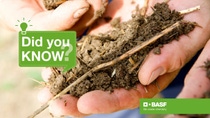Agriculture
Did you know a handful of healthy soil can contain more microorganisms than there are people on earth?

As part of its Biodiversity Strategy, the EU Commission is revising its Thematic Strategy for Soil Protection, including key threats to soil, such as erosion, floods, landslides, loss of organic matter, salination, contamination, compaction, sealing, and loss of soil biodiversity. It is calculated that one gram of healthy soil can contain up to 1 Billion microorganisms and several meters of fungal hyphae [1]. This is particularly important as soil microbes are fundamental to not only soil fertility but also, they are key providers of all types of environmental services.
Mitigating climate change has been highlighted as one of the objectives of the new common agricultural policy. The upper 30cm of soil is estimated to contain 680 Billion tons of carbon, almost double the amount which is present in the atmosphere [2] and has the capacity to hold up to 60% more. It would be possible to sequester even more carbon in soils globally, to reduce net CO2 equivalent emissions from agriculture and other industries into the environment. But what would that mean in practice?

There are different ways farming practices can help remove carbon from the atmosphere and capture it underground. These include using forests as carbon sinks, peatland restoration, breeding crops which can capture and store more organic carbon underground and adopting systems such as conservation tillage [3] which avoid disrupting soil structures and valuable soil organisms. Supported by society and the right policies, farmers can protect healthy soils, feed a hungry planet and make an important contribution towards achieving carbon neutrality by 2050.
[1] "The secret life of soil" by Prof. Peg Herring, director of communications for the College of Agricultural Sciences and editor of Oregon’s Agricultural Progress magazine at Oregon State University. https://extension.oregonstate.edu/news/secret-life-soil
[2] "World’s most comprehensive map showing the amount of carbon stocks in the soil launched" by FAO. http://www.fao.org/news/story/en/item/1071012/icode/
[3] Conservation tillage is an umbrella or generic term used to describe tillage systems that have the potential to conserve soil and water by reducing their loss relative to some form of conventional tillage. https://www.sciencedirect.com/topics/agricultural-and-biological-sciences/conservation-tillage